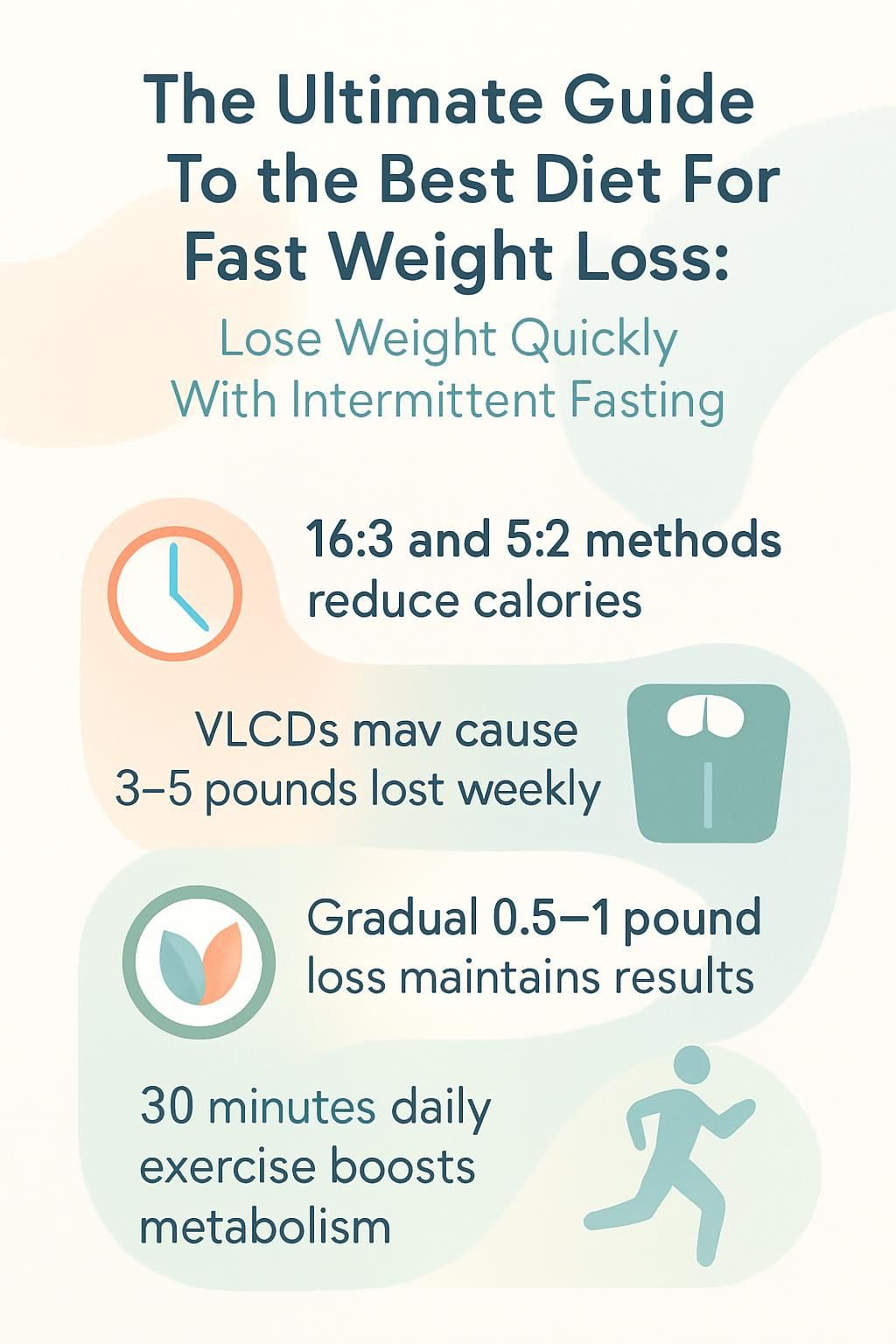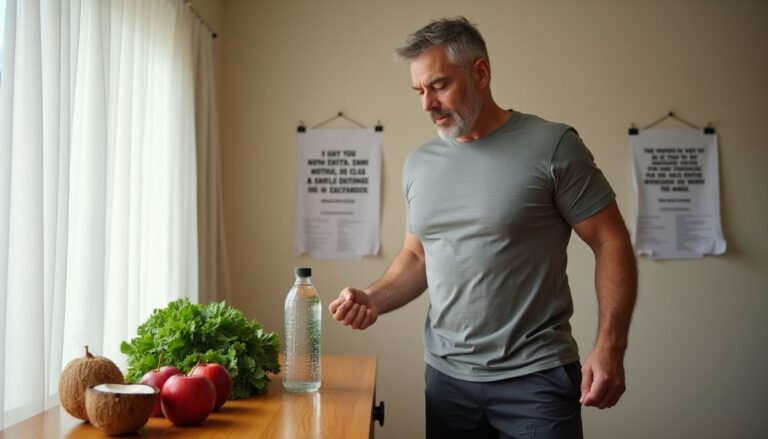The Ultimate Guide To The Best Diet For Fast Weight Loss: Lose Weight Quickly With Intermittent Fasting
Our Nutrition Assistant AI Suite will transform your body. You will lose fat, get toned, and build muscle. Gain confidence and optimal health.
You may feel stuck if diets have not helped you lose weight quickly or keep it off. Research suggests that intermittent fasting paired with smart food choices can deliver fast weight loss while protecting health.
This guide breaks down how fasting plans work, which foods support rapid fat loss, and how to build habits that last. You will learn simple steps you can start today.
Key Takeaways
- Intermittent fasting methods such as 16:8 and 5:2 reduce calories and may improve insulin sensitivity, which supports faster weight loss.
- Very Low Calorie Diets, near 800 calories a day, can produce 3 to 5 pounds lost per week, but they require medical supervision.
- Swap processed foods and refined carbs for lean protein, low carb vegetables, healthy fats like olive oil, and whole grains to sustain fat loss.
- Slow loss of 0.5 to 1 pound per week is easier to maintain than crash diets that increase the risk of muscle loss and weight regain.
- Combine a balanced diet with at least 30 minutes of daily activity to support metabolism and protect muscle during quick fat reduction.

Understanding Rapid Weight Loss

Fast results sound exciting, yet extreme tactics can backfire. Knowing the facts helps you choose a safe plan that fits your life.
What is rapid weight loss?
Rapid weight loss means losing more than 2 pounds, about 1 kilogram, per week for several weeks. Some people try to reach this pace with a Very Low Calorie Diet near 800 calories per day.
Doctors sometimes prescribe these plans for adults with obesity, and they monitor patients closely. VLCDs are not for children, teens, pregnant people, or older adults unless a clinician approves them.
Fast loss is rarely just fat. You can also lose water, muscle, and even bone. Side effects may include gallstones, fatigue, gout flares, constipation or diarrhea, and nausea.
Many people regain weight quickly after very strict diets. That rebound pattern, often called yo-yo dieting, is common.
After I tried an 800-calorie plan with my doctor for six weeks,says Jenny from Minnesota,I lost nearly 20 pounds but felt weak most days.
What are the common myths about fast weight loss?
Many claims sound simple, yet they are misleading. Fad diets like strict keto or very low carb plans often promise big drops, but severe cuts are hard to maintain and can harm health.
You may hear that you must cut entire food groups to see quick results. A balanced plan that includes healthy fats, lean protein, and whole grains tends to support long term weight control better.
Rapid drops often reflect water and muscle loss, not just body fat. That can drain energy and make workouts harder.
Another myth says quick changes are permanent. Most people regain pounds when they return to old habits. Safe progress aims for 0.5 to 1 pound per week with solid nutrition and regular movement.
Intermittent Fasting Basics and Methods
Intermittent fasting sets eating and fasting windows on a schedule. It can be flexible enough to match your routine.
What is intermittent fasting?
Intermittent fasting alternates periods of eating with set hours or days of fasting. It lowers average calorie intake, which can help you lose weight quickly if your total intake drops.
Short term studies show benefits for fat loss and metabolic health. Possible side effects include headaches, irritability, low energy, and constipation. People who are pregnant, breastfeeding, managing diabetes, or living with an eating disorder should not fast without medical care.
Drink water during fasting windows, and ask your clinician if you need a multivitamin. Long term safety data is still developing, so check with your doctor if you take any medicines.
Intermittent fasting uses planned periods without food to reduce calories and support weight loss.
What are the different intermittent fasting methods?
Several formats can fit your lifestyle. Choose one you can keep doing.
- The 16:8 plan keeps eating within an 8-hour window, such as 10 am to 6 pm, and fasting for 16 hours.
- The 5:2 method uses five regular eating days and two nonconsecutive days at about 800 calories.
- Eat-Stop-Eat includes one or two 24-hour fasts each week, which can be challenging at first.
- Alternate-day fasting switches between regular eating and fasting days, with some versions allowing up to 500 calories on fast days.
- Time-restricted feeding focuses on meal timing and can support steady loss with less strict calorie tracking.
- Some combine fasting with Mediterranean or ketogenic patterns, ideally with professional guidance when medical conditions are present.
- Results vary. Consider your health, schedule, and preferences, and talk with a dietitian or clinician before you start.
I paired a 16:8 schedule with a Mediterranean style menu for three months. Energy improved, and weight dropped steadily without feeling deprived.
How does the 16:8 method work?
You eat all meals and snacks within an 8-hour window, then fast for 16 hours including overnight. This approach focuses on timing, not strict food rules.
Many people find it easier than full-day fasts because it works with work, school, and family life. Water, black coffee, and unsweetened tea are fine during fasts and may ease headaches or fatigue.
Skip this plan if you are pregnant, have diabetes, or have a history of disordered eating unless your healthcare provider approves it. For many adults, it reduces calories and supports long term weight control.
How does the 5:2 method work?
The 5:2 plan divides the week into five regular eating days and two low calorie days. On fasting days, aim for about 800 calories with nutrient dense foods like vegetables, lean protein, and healthy fats.
People like the flexibility, since low calorie days do not need to be back to back. Planning meals before fasting days reduces stress and helps prevent overeating later in the week.
It is not for children, pregnant people, or those with certain medical issues without supervision. Talk with your clinician if you have chronic conditions.
How does the Eat-Stop-Eat method work?
Eat-Stop-Eat uses a full 24-hour fast once or twice per week. During the fast, stick to calorie-free drinks like water or black coffee.
This cuts weekly calories and can lead to rapid loss, but hunger and headaches are common at the start. If you have diabetes, kidney disease, or a history of eating disorders, seek medical guidance before trying this method.
What is alternating fasting days?
Alternate-day fasting means you eat normally one day, then fast or eat very few calories the next day. Many people allow up to 500 calories on fast days.
This pattern can reduce body fat and improve some heart health markers. It can also be tough to maintain due to hunger, low energy, or irritability. Hydration matters.
It is not appropriate for children, teens, pregnant people, or older adults unless a clinician approves it.
How Intermittent Fasting Promotes Weight Loss
Fasting helps you eat fewer calories and may improve how your body handles fuel. Think of it as a reset for timing and portions.
How does calorie restriction lead to fat loss?
Fat loss happens when you burn more energy than you eat. With fewer calories, your body taps stored fat for fuel to make up the gap.
On VLCDs near 800 calories, many people lose 3 to 5 pounds per week under medical care. A Low Calorie Diet of 1,200 to 1,500 calories for most women and 1,500 to 1,800 for most men supports steady loss with basic nutrition.
Very sharp cuts can reduce muscle and water if protein and strength training are too low. Meal replacements can help with vitamins and minerals on stricter plans. In general, aiming for 0.5 to 1 pound per week is safer and easier to keep.
How does metabolic rate affect weight loss?
Metabolic rate is how many calories your body burns at rest and during activity. If you cut calories too hard, your body may slow metabolism to conserve energy. That slow down can cause a plateau.
Protect your metabolism by eating enough protein and doing resistance training to maintain muscle. Many people do better with gradual calorie cuts and regular strength work.
I had more energy, and loss continued, when I lifted weights and kept some healthy carbs instead of slashing calories too low.
How do insulin levels impact fat storage?
Insulin is a hormone that helps move sugar from your blood into your cells. High insulin after sugary or high glycemic meals pushes your body to store fat.
Fasting periods and fewer refined carbs can lower insulin and improve insulin sensitivity. That shift encourages your body to burn stored fat for energy.
Choosing high fiber foods slows the rise in blood sugar after meals, which reduces insulin spikes and helps with long term weight control.
Effective Diet Plans for Quick Weight Loss
Some plans work faster than others. The best fit is one you can follow safely.
What role does a Low-Calorie Diet (LCD) play?
An LCD usually means 1,200 to 1,500 calories for most women and 1,500 to 1,800 for most men. Portion control and simple tracking are common tools.
LCDs are safer than VLCDs for most people and often produce 1 to 2 pounds lost per week. Some plans blend meal replacements with regular foods to make the routine easier to follow.
I lost nearly ten pounds using an LCD with more vegetables and lean protein from my own kitchen. Cravings dropped, and energy improved.
What are the benefits of a Very Low-Calorie Diet (VLCD)?
VLCDs can produce rapid loss for adults with obesity who need quick results, for example before bariatric surgery. Many people see 3 to 5 pounds lost per week at about 800 calories per day with medical supervision.
Shakes, bars, and soups can help meet basic nutrient needs despite tight limits. Some people also see better blood pressure, cholesterol, or blood sugar.
These plans are short term and require close monitoring due to risks like muscle loss and gallstones. They are not suitable during pregnancy or for children, teens, or older adults without clinician approval.
How does the Ketogenic Diet support weight loss?
The ketogenic diet is very low in carbohydrates and high in fat. Keeping carbs under about 10 percent of daily calories can trigger ketosis, a state where your body burns fat for fuel.
You eat more olive oil, nuts, eggs, poultry, and fish, and much less bread or pasta. Quick water loss often happens in week one as glycogen stores drop.
Some people see better insulin sensitivity and lower blood sugar, yet side effects can include headaches, constipation, or nutrient gaps if meals are not planned. Long term adherence is hard for many, so talk with your clinician before starting.
What advantages does the Mediterranean Diet offer?
The Mediterranean Diet emphasizes vegetables, fruits, whole grains, beans, nuts, seafood, and healthy fats like olive oil. It is flexible, flavorful, and linked to lower risks of heart disease, stroke, diabetes, and some cancers.
A sample 1,200 calorie day could include overnight oats with berries, white bean soup for lunch, and roast chicken with colorful vegetables at dinner. This style supports steady, maintainable weight control.
When I leaned into more seafood and plant based meals during a busy summer in Florida, my weight held steady and energy stayed high.
Best Foods to Eat for Faster Weight Loss
Food choices can speed progress and improve digestion. Focus on protein, fiber, and healthy fats.
Which high-protein foods are essential?
Lean meats like chicken breast, turkey, and pork tenderloin provide protein with less saturated fat. Fish such as salmon and tuna add protein and heart healthy fats.
Eggs, Greek yogurt, cottage cheese, beans, lentils, and soy foods are excellent too. Aim to include protein at each meal to protect muscle and manage hunger.
When I swapped my breakfast for eggs and added a Greek yogurt snack, sticking to a lower carb plan felt easier all day.
What are the best low-carb vegetables to eat?
Nonstarchy vegetables are filling and low in calories. Great choices include broccoli, bell peppers, onions, tomatoes, spinach, zucchini, cauliflower, and leafy greens.
These foods deliver vitamins, minerals, and antioxidants that support metabolic health. High fiber vegetables help keep blood sugar steady, which supports fat loss.
What are good sources of healthy fats?
Choose fats that support heart and metabolic health. Fatty fish like salmon, sardines, and mackerel supply omega-3 fats.
Nuts and seeds, such as almonds, walnuts, pistachios, chia, and flax, offer fiber and protein. Use extra virgin olive oil for salads and roasting.
Avocados add flavor, healthy fats, and fiber. Keep portions modest because fats are calorie dense. Limit saturated fats from fatty meats and avoid trans fats found in some packaged snacks.
How do whole grains and fiber help weight loss?
Whole grains and other high fiber foods increase fullness and support steady energy. Artichokes, lentils, lima beans, whole oats, barley, brown rice, and berries are strong options.
Fiber slows digestion, blunts blood sugar spikes, and supports regularity. Increase fiber gradually and drink water to reduce gas or bloating.
Foods to Avoid for Better Weight Loss Results
Some foods make progress harder than it needs to be. Limiting them can improve your results.
Why should processed foods and sugary snacks be avoided?
Processed snacks and sugary drinks are calorie dense and easy to overeat. They raise blood sugar quickly, which can lead to more hunger soon after.
Keeping added sugars under 10 percent of daily calories is a helpful target. Replacing sweets with fruit or a small handful of nuts can curb cravings and support satiety.
How do refined carbohydrates affect weight loss?
Refined carbs like white bread, rice, and many pastas digest quickly and spike insulin. High insulin levels push your body to store fat and can increase hunger later.
Swapping refined grains for whole grains improves fullness and reduces cravings. I noticed more stable energy after I switched from white bread to whole grain options.
Reference: Carbohydrates: Quality Matters, Harvard T.H. Chan School of Public Health.
What are the dangers of trans fats and fried foods?
Trans fats raise LDL cholesterol and lower HDL cholesterol, which increases heart disease risk. Fried foods are high in unhealthy fats and often sodium.
Regular intake can lead to weight gain, inflammation, and insulin resistance. Choose unsaturated fats such as olive oil, nuts, and seeds instead.
How Exercise Supports Rapid Weight Loss
Movement helps you lose weight faster and protects muscle during a calorie deficit. Think of exercise as a steady partner to a healthy diet.
How can diet and exercise be combined for best results?
Diet creates most of the calorie deficit, while exercise supports muscle and mood. Aim for at least 30 minutes of activity most days.
Start at your current fitness level and build up over time. Keep records with a simple app or notebook to track food, workouts, and sleep.
Strength training helps preserve muscle, which supports your metabolic rate. If you have medical conditions, ask your provider before beginning hard workouts.
What workout routines are effective for weight loss?
- Walk briskly for at least 30 minutes most days. It is easy on joints and simple to schedule.
- Use cardio like jogging, cycling, or swimming to burn more calories and support heart health.
- Lift weights or use resistance bands three days per week to maintain muscle.
- Apply progressive overload. Add a little weight, sets, or reps over time to keep improving.
- Mix cardio, strength, and mobility work such as yoga or Pilates for balance and injury prevention.
- Use short sessions when busy. Ten minute bouts add up throughout the day.
- Pick activities you enjoy so consistency stays high over months, not just weeks.
I paired morning walks with resistance bands during a 16:8 plan and lost five pounds in two weeks without feeling worn out.
Personal experience shared; results vary.
What cardiovascular exercises are best?
Walking, jogging, cycling, and swimming are reliable calorie burners. Start easy, then raise intensity as your fitness improves.
Split cardio into shorter sessions if needed. Combining cardio with strength work supports faster fat loss and helps maintain muscle.
What are the essentials of strength training?
Use enough resistance so the last two reps feel challenging with good form. Include compound moves like squats, presses, and rows, plus isolation moves such as curls and calf raises.
Train each major muscle group at least twice a week. Rest muscles for one to two days between sessions. A simple log helps you track sets, reps, and progress.
Health Benefits of Intermittent Fasting
Many people report better energy and steadier moods with a thoughtful fasting plan. The benefits can extend beyond the scale.
How does intermittent fasting boost metabolic health?
Fasting windows can improve insulin sensitivity, which helps your body control blood sugar. Better insulin response supports fat loss and metabolic health.
During fasting, insulin drops and growth hormone may rise. That shift encourages your body to use stored fat for fuel. Some people also see improved cholesterol profiles over time.
Can intermittent fasting enhance cognitive function?
Short term research suggests fasting may sharpen focus and mental clarity. Reduced inflammation and steadier blood sugar may help your brain work more efficiently.
On my 16:8 days, I noticed better focus through late morning before my first meal.
How does intermittent fasting reduce body inflammation?
Fasting can lower inflammation markers such as C-reactive protein. It may also support autophagy, a process where cells clear damaged parts.
Cutting late night snacks and added sugars helped my joints feel less stiff after a few weeks.
Risks and Safety Considerations of Intermittent Fasting
Fasting is not right for everyone. Safety comes first, especially if you take medications or manage chronic conditions.
Who should avoid intermittent fasting?
Children, teens, pregnant or breastfeeding people, and older adults should avoid fasting unless a clinician approves it. Bodies in growth or later life stages often need steady nutrition.
If you have diabetes or take medicines that affect blood sugar, do not fast without medical guidance. Anyone with a history of eating disorders should avoid restrictive plans.
I once skipped breakfast while on a prescription and crashed midmorning. Talk with your provider before changing your routine if any of these apply to you.
What are the signs of unhealthy weight loss?
Losing more than 2 pounds per week for several weeks can be a red flag. Warning signs include constant fatigue, dizziness, nausea, and digestive problems.
Dull skin, muscle loss, or gallstones can also occur with extreme diets. If you live with diabetes or a history of disordered eating, rapid changes raise your risk of complications.
Safe progress uses balanced meals and moderate activity. Extreme restriction harms health and often leads to rebound weight gain.
How to Maintain Weight Loss Successfully
Keeping weight off depends on daily habits you can repeat. Small actions, done often, make the biggest difference.
What strategies help sustain healthy eating habits?
- Track food with a journal or app to see patterns and make small fixes.
- Add one extra serving of fruits or vegetables to each meal to raise fiber.
- Practice mindful eating. Slow down and check hunger and fullness cues.
- Set realistic goals such as 1 to 2 pounds lost per week.
- Build a support team of friends, family, or an online group.
- Spot emotional triggers and consider a registered dietitian for guidance.
- Meal prep once or twice a week to reduce last minute takeout.
- Focus on whole foods such as lean protein, whole grains, legumes, nuts, vegetables, and fruits.
- Right size portions with smaller plates or simple measuring tools.
These steps build consistency. Consistency builds results.
How can you avoid the yo-yo dieting effect?
Set a pace of 0.5 to 1 pound per week. Avoid extreme rules that lead to binge and restrict cycles.
Use mindful eating, portion control, and daily activity to keep progress steady. Track your choices to spot trouble early and adjust.
I stopped bouncing up and down only after I chose slower, steadier changes I could keep. That shift made the difference.
Summary: Gradual goals, balanced food, regular movement, and mindful habits help prevent regain after weight loss.
Common Questions About Fast Weight Loss and Intermittent Fasting
These answers help you decide if fasting is a good fit and what timeline to expect.
Is intermittent fasting suitable for everyone?
No single plan works for all people. Those who are pregnant, breastfeeding, managing diabetes, or living with an eating disorder face higher risks and need medical oversight.
Headaches, low energy, irritability, and constipation can occur as you adjust. Focus on nutrient dense foods and gradual changes, and check with your healthcare provider first.
How long does it take to see weight loss results?
Many people notice changes within 1 to 2 weeks on a healthy plan. A safe rate is about 1 to 2 pounds per week.
VLCDs can reach 3 to 5 pounds per week but require medical care. Steady progress tends to last longer than quick fixes.
Conclusion
Fast weight loss works best with a plan you can sustain. Intermittent fasting, paired with whole foods and regular activity, can help you lose weight quickly while protecting your health.
Choose a method like 16:8 or 5:2, eat lean protein, vegetables, whole grains, and healthy fats, and move your body most days. Avoid crash diets that lead to rebounds. If you have medical concerns, talk with your clinician before you begin.
Small steps done daily lead to lasting change. That is how you lose weight and keep it off.
FAQs
1. What is intermittent fasting and how does it support fast weight loss?
Intermittent fasting involves cycling between periods of eating and not eating. Research shows this method can help reduce calorie intake, improve metabolism, and promote fat loss. Studies from the National Institutes of Health report that people following intermittent fasting often lose more weight than those on traditional calorie-restricted diets.
2. Are there risks or side effects with intermittent fasting for quick weight loss?
Some individuals may experience hunger, headaches, or fatigue during the adjustment period. People with certain health conditions should consult a healthcare provider before starting any new diet plan. Clinical trials indicate most healthy adults tolerate intermittent fasting well when they stay hydrated and eat balanced meals during eating windows.
3. How do I choose the best diet plan to combine with intermittent fasting for faster results?
Selecting a nutrient-rich meal pattern supports safe and effective weight loss while practicing intermittent fasting. Diets high in lean proteins, vegetables, whole grains, and healthy fats provide energy without excess calories. Data from Harvard Medical School suggest combining these foods with time-restricted eating leads to greater fat reduction compared to low-nutrient diets.
4. Can you share a personal example of success using this approach?
After trying several methods without lasting results, I adopted an eight-hour daily eating window paired with balanced meals focused on protein and fiber-rich foods like chicken breast and leafy greens. Over three months I lost fifteen pounds while maintaining muscle mass; my energy levels improved as well.
Summary: Intermittent fasting helps many people lose weight quickly by reducing calories consumed within set hours each day; pairing this strategy with nutritious food choices increases effectiveness according to clinical research findings.







